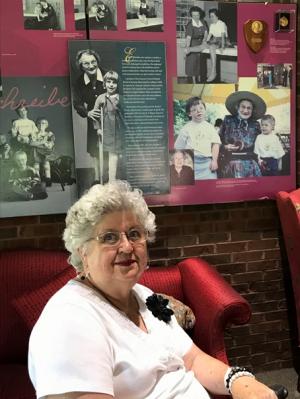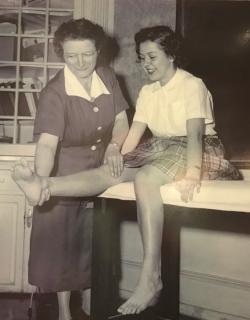One woman’s personal connection to Edna Schreiber
May 31, 2018Barbara Willders Tomlinson heard recently there was a photo of her as a girl on the wall at Schreiber, and she stopped by the center recently to see it.

“There I am,” she said, pointing up at a photos that’s part of the large Edna Schreiber piece that hangs in our main waiting area.
Barbara Willders is 82 now. She grew up in Lancaster and was slated to go to the George Washington School for seventh grade in 1949.
Then polio interrupted. She was 13 years old.
That year, 1949, was six years before the polio vaccine, and Barbara was one of 947 cases of the disease in Pennsylvania out of more than 42,000 cases nationwide, the second highest number on record, according to archival statistics from the Centers for Disease Control and Prevention.
Barbara said she spent two weeks in the hospital and recuperated at home for most of the summer. She was able to attend school when students headed back in September.
“I was not paralyzed, but I walked funny afterward,” she said. “They used to let me go down the stairs first, by myself. And I had to wear these ugly brown shoes with big straps for about a year.”
She worked with Edna Schreiber weekly, using the Sister Kenny hot blankets that Edna had incorporated into her therapy work to restore muscle tone and movement.
“I would be wrapped up from my neck down to my feet,” Barbara said.
Her therapy continued through her time in seventh grade. She said Edna would pick her up at school, and they would go to what was then known as the Society for Crippled Children and Adults, where Edna worked.
“She was very kind and sweet,” Barbara said. “She would lay me down and have me do things, see how my legs were working.”

That’s pretty much what’s happening in the photo: Barbara is sitting on a table, and Edna is helping her straighten her right leg. Barbara is wearing a plaid skirt and a white blouse.
“That’s probably what I wore to school that day,” she said.
I helped her into a chair to pose for a picture. She uses a walker, but it’s not because of any lingering effects of the polio. An inner ear problem has left her with occasional dizziness and difficulties with balance.
She looked up at the photo again. She said she worked with Edna for about a year, and by eighth grade, she was mostly OK.
“I was one of the lucky ones,” she said.
Seventy years later, she was able to see how the work of Edna Schreiber continues. And she was able to see her own place in that history.